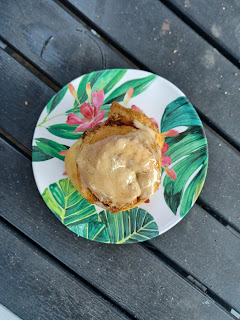Taken from King Arthur Baking / Carla Hall
PREP: 30 mins / BAKE: 50 to 55 mins / TOTAL: 1 hr 45 mins
YIELD: one 10" Bundt cake
Ingredients
CAKE
- 2 1/4 cups (270g) King Arthur Unbleached All-Purpose Flour
- 1 1/2 cups (298g) granulated sugar
- 1/2 cup (106g) light brown sugar or dark brown sugar, packed
- 1 teaspoon baking soda
- 1/2 teaspoon salt
- 1 teaspoon cinnamon*
- 1 teaspoon nutmeg
- 1 teaspoon star anise, ground
- 1 1/2 cups (340g) root beer, flat or fizzy
- 16 tablespoons (227g) unsalted butter, room temperature
- 1/4 cup (21g) unsweetened cocoa, Dutch-process or natural
- 2 large eggs, at room temperature
- 1/2 cup (113g) buttermilk, at room temperature
- 1 teaspoon vanilla extract
- 1 teaspoon fresh ginger, grated fresh
- *The original recipe calls for smoked cinnamon; if you can find it, by all means use it.
GANACHE
- 1/4 cup (57g) root beer, flat or fizzy
- 4 tablespoons (57g) unsalted butter, room temperature
- 1 1/2 tablespoons unsweetened cocoa, Dutch-process or natural
- 2 cups (227g) confectioners' sugar
- 1/8 teaspoon nutmeg
- 1/8 teaspoon star anise, ground
- 1/4 teaspoon salt
Preheat the oven to 350°F. Grease a 10-cup Bundt pan, a 9" x 13" pan, or two 9" round cake pans.
To make the cake: In a large bowl, whisk together the flour, sugars, baking soda, salt, and spices. In a medium saucepan, bring the root beer, butter, and cocoa powder to a boil, stirring occasionally. Remove from the heat, cool for 5 minutes, then mix into the flour mixture.
In a small bowl, whisk together the eggs, buttermilk, and vanilla and stir into the flour mixture. Fold in the grated ginger.
Transfer the batter to the prepared pan(s) and bake for 50 minutes for a Bundt cake, 35 minutes for a 9" x 13" cake, or 33 to 35 minutes for 9" layers, until the edge of the cake begins to pull away from the pan and a toothpick inserted in the center comes out clean.
Remove the cake from the oven. Gently loosen it from the pan around the edge, if you can. Place a cooling rack on top, across the surface of the cake. Very carefully turn the cake and rack over so that the cake (in its pan) is resting on the rack. Wait 15 minutes, then carefully lift the pan off the cake, jiggling it gently first to make sure it's not stuck.
To make the ganache: In a small saucepan, bring the root beer to a boil over medium heat. Add the butter and cocoa powder, stirring until smooth. Pour the mixture into a large bowl, then whisk in the confectioners' sugar, spices, and salt until smooth and glossy. Pour over the top of the cake while still warm.
Storage information: Store any leftover cake, well wrapped in plastic, at room temperature for several days; freeze for longer storage.
My Notes: This was a great cake. Super soft--like eating a chocolate pillow. I used diet root beer and the cake was still plenty sweet. I also ran out of root beer so used ginger beer for the ganache. And no ground anise. I put a whole pod in the boiling root beer mixture. Cooked 50 minutes, cooled 15. MXF



